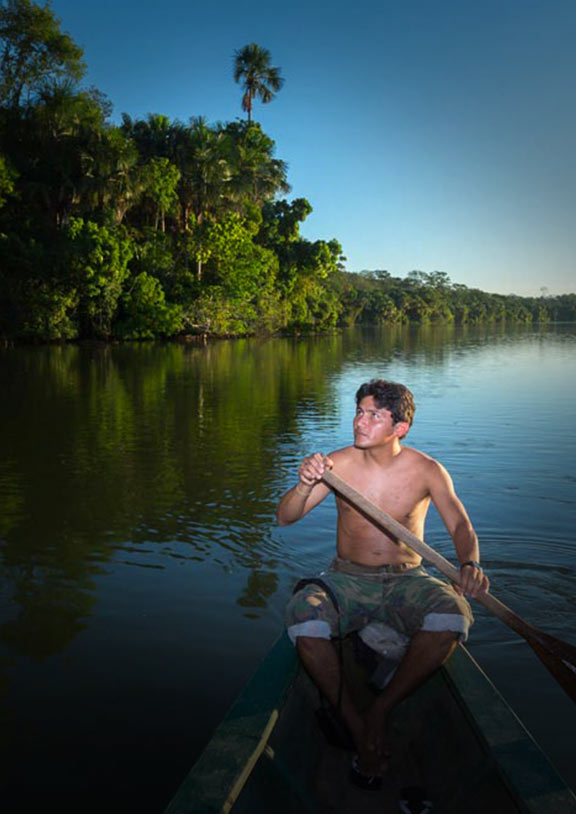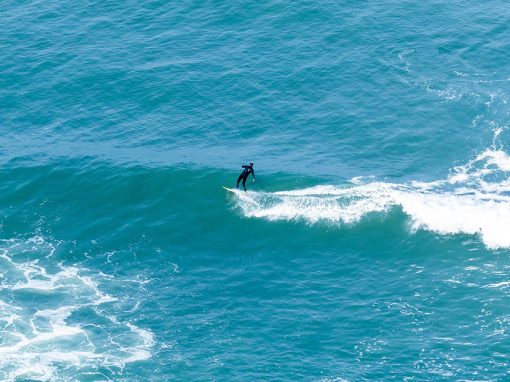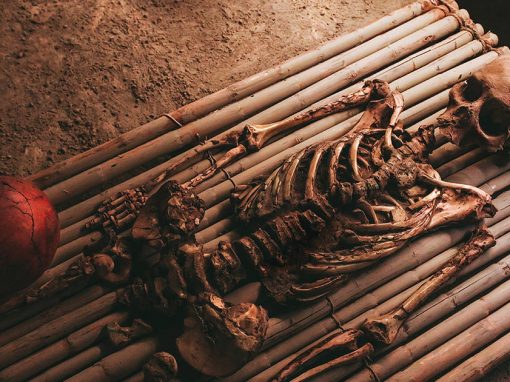I had no intention of traveling through Peru, and certainly didn’t expect to find myself living in Mancora, a small beach town in the northern part of the country. My boyfriend and I had moved to Quito to finish our novels, but after 5 and ½ months the Ecuadorian government was kicking us out. Apparently they didn’t care that we hadn’t yet finished the manuscripts we had vowed we wouldn’t return home without. We had no choice but to pack up and head south.
I hadn’t even heard of Mancora until I became horribly sick on the bus while border crossing into Peru. Desperate for a soft bed, I leafed through my newly purchased guidebook to find the next town where I could jump off the bus and rest for a few days. The guidebook describes Mancora as a small fishing village turned surfer’s paradise. This sounded perfect to me, and is a pretty accurate description- at least superficially.

Beachside restaurants, Mancora
There is a pier to the south of town where you can buy inexpensive fresh fish right off the dock. In the mornings, you can watch the fisherman unload their day’s catch and send it via mototaxi to the town’s market. And of course, there’s the beach. This entire region of Peru is hot and dry, with a cool ever-present breeze and much warmer water than southern Peru. This ideal weather combined with the large crescent shaped white-sand beach makes Mancora a Mecca for sunbathers, surfers, kite-surfers, kayakers, snorkelers, and divers who can be seen soaking up the atmosphere year round.
We immediately became smitten with the beautiful beach and the tiny town itself. This was our first stop in Peru and Mancora is pretty idyllic. Coming from Ecuador, Mancora seemed easy, convenient, and cheap, which we have since learned is hilarious to Peruvians who consider it remote and expensive. But to us the stores were stocked with foods we couldn’t find in Ecuador, and for cheaper prices, which was exciting. And of course the beach was a welcome change from the Andes.
Completely abandoning our plans to head straight to Cusco and explore the Sacred Valley and Machu Picchu, we rented a three story furnished beach-front house along the road to Mancora Chico for 325 USD per month and settled right in. Our bedroom had French doors which opened onto a large balcony with stunning views of little fishing boats gently rocking, and the white sand stretching on and on before it curved around bluffs in the distance.
View from our terrace, Mancora, Peru
When we first arrived, the town was pretty quiet and seemed to be a mixture of beach bums in their mid-twenties to mid-thirties and young, gorgeous people overflowing from the two new hostels in town, The Point and Loki. These two hostels are really quite swanky and are enclosed by huge gates with guards who block the doors. The vacationers who stay at these two fortress-like hostels very rarely seem to tear themselves away from the interior pools, huge bars, and on-site restaurants.
This complete disinterest in the town and the locals by these young beach bunnies, makes Mancora look slightly more bohemian at first glance than perhaps it really is. The people who actually do hang out in the small town and on the beach tend to either wear linen pants and adorn their hair with shells, or have a perpetual tan and lean muscles from year-round surfing. The craft market in the central square and the road to the beach are full of these international travelers, mostly from other South American countries, selling homemade jewelry and wood carvings for part of the day, and surfing or playing instruments on the beach in the afternoons. Although there are far fewer of this type of traveler, they are more visible and give the town a laid-back hippie vibe.
The two new hostels have changed the town a lot according to locals. Although Mancora gets more visitors now, these two hostels see most of the money from young budget travelers. They are almost always full to capacity and because guests have everything they could want right there, including all the other people their age, they are less inclined to go out and try the other bars and restaurants. None of the locals seemed resentful however, they just acknowledged that they need to try to offer something different to lure the travelers to their establishments.
This mellow, although divided Mancora stayed like this for the first 6 weeks we were there, and we assumed this is what Mancora was like all the time. Then one day everything in the stores became 30 percent more expensive, and the next day the town was flooded with travelers in expensive SUVs and luxury cars, the beach packed with everyone from more gorgeous young people, to families with children, and retired couples. But perhaps most shocking was what had once been our own private house now had various other travelers stuffed into the empty bedrooms.
What the guidebook didn’t mention is that Mancora is not only the lazy beach town it appears to be to people passing through, but also a popular winter getaway for wealthy Limenos during the peak travel season between July and August. When the Limenos arrived, the police, who we hadn’t even seen before, asked many of the hippie travelers to pack up their jewelry and craft stands and move along to another beach, and most of them did. What was days ago a small town where you could always get a seat, the locals knew your name, and where you inevitably saw people you had met the night before, becomes as anonymous and crowded as a city. We saw both seasons, and the transformation during our second month was staggering.
Since having moved to Lima, people are often shocked that we stayed in Mancora for two months as they assume it is incredibly expensive and only a party town. That wasn’t our experience of Mancora at all, at least until the end when the Limenos arrived. The six weeks prior to that were quiet and lazy with days full of writing, swimming, snorkeling, horseback riding, kayaking, and playing with friendly cats and dogs loitering in doorways.

Downtown Mancora before the busy season
And I also didn’t find Mancora all that expensive. There are tons of cheap hostels all through town that charge about 15 soles per person per night and the food market where we shopped, practically devoid of other tourists, is the same price as the food markets in Lima. Many tourists don’t even realize there is a market in Mancora because you can’t see it from the main street in town. It’s one block east of the Pan America highway behind the Cruz del Sur bus station.
Once you do find it, you’ll see narrow walkways lined with glistening fish and bins full of shrimp and clams, unusually large fruits and vegetables precariously perched atop one another, and cow’s legs hanging from metal poles above butcher’s heads. Stray dogs and cats wander through this market and shopper’s feet, seeking pats from children and scraps from vendors.
Budget travelers can also find ceviche for 3 soles, set 3-course lunch menus for 7 soles, and a place to refill water jugs for 3 soles. The trick to making Mancora cheap is to have access to a kitchen, shop at the market, refill your own water jugs instead of buying new ones, and whenever and wherever possible make friends with the bartenders. The best way to find an affordable house is not the Viva Mancora website, which most people will recommend, but rather through word of mouth.
The best deal in town for mid-range options is Casa Blanca Hotel along the Pan America Highway. For 20 soles per person we had a nice room with a large, comfortable bed, a mini fridge, television with cable, a private bathroom with hot water, Wi-Fi, and kitchen access.
Mancora’s activities typically revolve around the beach, but it’s also a great place to go whale watching August through October when Humpback whales pass through here on their way to southern Ecuador. There are also horseback riding tours and just about every water sport imaginable.
The best restaurant in town is La Sirena, which is absolutely charming with an interior décor blending shabby chic with artsy bohemian and serving delicious classics with a trendy twist. My favorites were the yam raviolis served in a porcini mushroom sauce with bacon, the seared tuna salad, and the slow roasted goat. Another great find, and much cheaper than La Sirena, is an upstairs restaurant called Los Negros with an expertly designed menu that changes nightly. The seared tuna steaks covered in a sweet fig sauce impressed me to no end.

A typical sunset in Mancora
I think the best thing about Mancora is that you can spend as little or as much money, and be as social or as isolated, as you want. If you want to party all night long, stay in luxury hotels and take kite surfing lessons, you can. If you want to live on 15 USD per day, perfect your tan, and surf, you can do that too. The party town to Peruvians, the surfer’s town to travelers, my Mancora is sitting on the balcony watching the outlines of pelicans diving against a spectacular sunset.
For more information about Peru travel packages, please contact one of our expert travel advisors.

Challen is a contributing writer for our travel blog.










Pingback